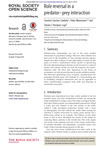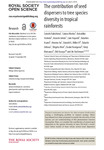Search
Now showing items 1-6 of 6
Role reversal in a predator–prey interaction
(2014)
Predator–prey relationships are one of the most studied interactions in population ecology. However, little attention has been paid to the possibility of role exchange between species, despite firm field evidence of such ...
The contribution of seed dispersers to tree species diversity in tropical rainforests
(2015)
Tropical rainforests are known for their extreme biodiversity, posing a challenging problem in tropical ecology. Many hypotheses have been proposed to explain the diversity of tree species, yet our understanding of this ...
African origin for Madagascan dogs revealed by mtDNA analysis
(2015)
Madagascar was one of the last major land masses to be inhabited by humans. It was initially colonized by Austronesian speaking Indonesians 1500–2000 years ago, but subsequent migration from Africa has resulted in approximately ...
Improved community detection inweighted bipartite networks
(2016)
Real world complex networks are composed of non random quantitative interactions. Identifying communities of nodes that tend to interact more with each other than the network as a whole is a key research focus across ...
Adaptive collective foraging in groups with conflicting nutritional needs
(2016)
Collective foraging, based on positive feedback and quorum responses, is believed to improve the foraging efficiency of animals. Nutritional models suggest that social information transfer increases the ability of foragers ...
Computational model of collective nest selection by ants with heterogeneous acceptance thresholds
(2015)
Collective decision-making is a characteristic of societies ranging from ants to humans. The antTemnothorax albipennisis known to use quorum sensing to collectively decide on a new home emigration to a new nest site occurs ...






